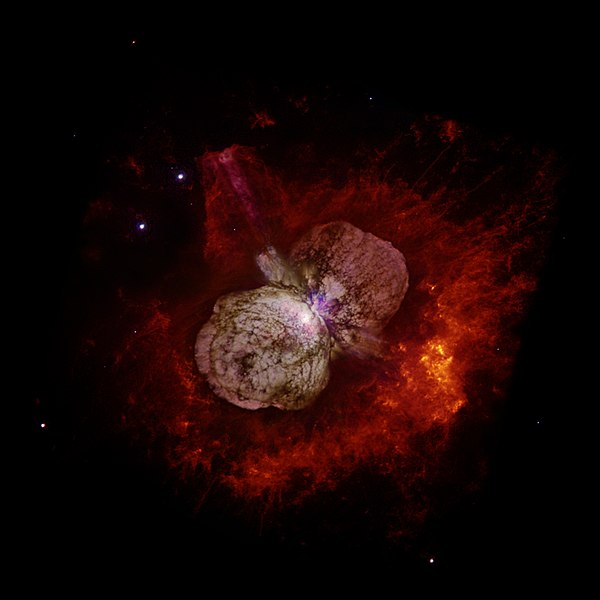Page 2 of 2
Re: APOD: The Orion Bullets (2013 Jan 10)
Posted: Fri Jan 11, 2013 11:27 pm
by Boomer12k
alter-ego: Thanks for the photo comparisons and the wider field one.
And an Optimist could be an experienced Pessimist. It depends on the things you are learning.
:---[===] *
Re: APOD: The Orion Bullets (2013 Jan 10)
Posted: Sat Jan 12, 2013 5:03 am
by alter-ego
Boomer12k wrote:alter-ego: Thanks for the photo comparisons and the wider field one.
You are very welcome.
And an Optimist could be an experienced Pessimist. It depends on the things you are learning.
Now
that's optimistic!

Re: APOD: The Orion Bullets (2013 Jan 10)
Posted: Sat Jan 12, 2013 6:44 am
by Ann
Boomer12k wrote:alter-ego: Thanks for the photo comparisons and the wider field one.
And an Optimist could be an experienced Pessimist. It depends on the things you are learning.
:---[===] *
I agree with Boomer12k on both counts.
Anyway, alter-ego: Do keep up your gracious service to everyone here at Starship Asterisk*, by showing us photo comparisons and wider field images so that we can get a better idea of what and where the APOD in question is! (Not every day, of course, goodness me, but now and again!) Thank you so much!
Ann
Re: APOD: The Orion Bullets (2013 Jan 10)
Posted: Sat Jan 12, 2013 11:19 pm
by Beyond
And... an experienced optimist could end up being very pessimistic about everything, as a whole.
Re: APOD: The Orion Bullets (2013 Jan 10)
Posted: Mon Jan 14, 2013 12:07 am
by Drifting
So, are the telescope's five laser-generated stars visible in this image of the Orion Bullets??? If so it would be nice to know where in the image they are!
Re: APOD: The Orion Bullets (2013 Jan 10)
Posted: Mon Jan 14, 2013 12:36 am
by Chris Peterson
Drifting wrote:So, are the telescope's five laser-generated stars visible in this image of the Orion Bullets??? If so it would be nice to know where in the image they are!
I doubt it. The laser stimulates a specific narrow wavelength, which is filtered out by the correction optics. That light doesn't make it to the imaging camera. Presumably, the reference stars are distributed in the field- probably one in the center and the others in the quadrants, but more optimal configurations might be possible.
Re: APOD: The Orion Bullets (2013 Jan 10)
Posted: Mon Jan 14, 2013 3:50 am
by Chappy
There is one star at the bottom left of this image (2nd star from left edge right at the bottom) that appears to have two jets of material, perfectly perpendicular to the star. These appear to be very similar in looks to x-ray images of jets emanating from galactic central regions. Is this just a chance overlay of foreground (or background) bullet material on an unrelated star? Must be otherwise I'm sure they would have been mentioned something about it..wouldn't they?
Re: APOD: The Orion Bullets (2013 Jan 10)
Posted: Mon Jan 14, 2013 4:17 am
by Chris Peterson
Chappy wrote:There is one star at the bottom left of this image (2nd star from left edge right at the bottom) that appears to have two jets of material, perfectly perpendicular to the star. These appear to be very similar in looks to x-ray images of jets emanating from galactic central regions. Is this just a chance overlay of foreground (or background) bullet material on an unrelated star? Must be otherwise I'm sure they would have been mentioned something about it..wouldn't they?
Looks to me like a shock front in the surrounding gas, not a jet.
Re: APOD: The Orion Bullets (2013 Jan 10)
Posted: Mon Jan 14, 2013 4:38 am
by alter-ego
Chris Peterson wrote:Drifting wrote:So, are the telescope's five laser-generated stars visible in this image of the Orion Bullets??? If so it would be nice to know where in the image they are!
I doubt it. The laser stimulates a specific narrow wavelength, which is filtered out by the correction optics. That light doesn't make it to the imaging camera. Presumably, the reference stars are distributed in the field- probably one in the center and the others in the quadrants, but more optimal configurations might be possible.

- 5-pt Locations and Sizes
Yes, the light is filtered and therefore not visible to GeMS, but other facilities are / can operate sensitive to the sodium line (589nm). There are protocols that define how, when and where the guides stars can be used.
The particular 5-star foot print and sizes are shown in the picture. Note the FoV is the same size as the APOD. I believe they limit the image / guide star separation to something like 25 arcsec.
Re: APOD: The Orion Bullets (2013 Jan 10)
Posted: Tue Jan 15, 2013 8:12 pm
by neufer
http://en.wikipedia.org/wiki/Homunculus_Nebula wrote:
<<The Homunculus Nebula is an emission nebula surrounding the massive star system
Eta Carinae. The nebula is embedded within the much larger
Eta Carinae Nebula, an ionized hydrogen (H II) region. The Homunculus (from the Latin meaning Little Man) is believed to have been ejected in an enormous outburst from Eta Carinae. Light from this event reached Earth in 1841, creating a brightening event in the night sky which was visible from the Earth's surface at the time. During the event (as seen from Earth) Eta Carinae briefly became the second-brightest star in the sky, after Sirius; but the ejected gas and dust have since obscured much of its light.>>
I wonder if 800 years from now the Homunculus Nebula in the
Eta Carinae Nebula will resemble Orion "bullets" in the Orion Nebula.
